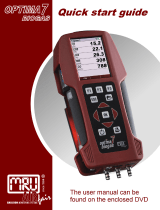
J100000000SE 041663 130723
10
4.0 DESCRIPTION OF THE PRODUCT
4.1 Working principle
The gas sample is taken in, through the smoke probe, by a membrane pump inside the instrument.
The probe is featured with a sliding fitting-cone that allows the probe itself to be inserted into holes with a diameter from 11 mm to 16 mm, and
to set the immersion depth: the smoke pick-up point must approximately correspond to the center of the satck.
The gas sample which must be analyzed must be taken to the measurement sensors dehumidified and purified from solid combustion
residues.
In order to achieve this, a water trap is used, which is a transparet plastic cylinder placed inside the instrument.
Its purpose is to decrease the speed of the air in order to precipitate the heavier dust particles and condense the vapor contained in the
combustion gases.
During operation, the instrument must be placed in a vertical position (with the pneumatic connections facing downwards).
For the same reason it is important to drain the trap periodically and in any case after the end of the test. A low porosity replaceable line
filter it is placed on the condensation trap and it has the purpose of retaining the solid particles remaining suspended in the gases. It is
recommended to replace the filter if it is visibly dirty (see chapter “Maintenance”).
The gas is then analyzed in its components by the installed sensors.
The electrochemical sensor grants very precise results in a time interval up to about 60 minutes, time interval when the instrument
calibration can be considered very stable. When it is necessary to perform log time measurements, it is advisable to make a new
instrument autozero by letting clean air flow inside the pneumatic circuit for three minutes. During the zero calibration phase, the
instrument sucks in clean air from the environment and detects the zero drift of the sensors (20.95% for the O2 sensor), it compares them
with the programmed values, and then proceeds to their compensation.
During the autozero phase of the gas sensors, the zero of the pressure sensors is also performed.
The UNI 10389-1 (2019) standard requires that the instrument is calibrated in an authorized laboratory in order to obtain a calibration
certificate once a year.
4.2 Measurement sensors
The instrument uses pre-calibrated gas sensors.
The sensors do not require special maintenance, but must be replaced periodically when exhausted.
The oxygen measurement (%O2) is performed with an electrochemical cell that behaves like a battery that is subject, over time, to lose
sensitivity due to the fact that 20.9% oxygen is always present in the air.
Toxic gases measurements (CO, SO2, NO, NO2) are carried out with electrochemical sensors that are not subject to natural deterioration
because they are intrinsically free from oxidation processes.
Toxic gas sensors, if subjected to concentrations higher than 50% of their measuring range for more than 10 minutes continuously, may
show a drift of ± 2% and an longer zeroing times.
In this case, before turning off the analyzer, it is advisable to wait until the measured value is less than 20ppm by sucking in clean air.
In any case, the instrument provides a cleaning cycle of the pneumatic circuit, the duration of which depends on the setting made in the
Configuration menu.
The gas must not be at a pressure that can damage or destroy the sensors; for this reason the suction pump is continuously regulated, so
as to guarantee an appropriate flow to the sensors. The maximum allowed pressure is ±100 hPa.
Equipped with a solenoid valve for automatic autozero, the instrument performs an automatic cleaning cycle and turns off when the
sensors have returned to a value close to zero.
WARNING!
Some sensors (for example NH3, H2, H2S, SO2,...) are sensible to other gases called interfering gases.
On the analysis phase, the influence of interfering gases is compensated only if on the instrument are
installed the correspondent sensors.
4.3 CO dilution (if the configuration allows it)
One of the characteristics of the electrochemical sensor for the measurement of CO is the need to require very long self-calibration time
in case it has been in contact with high gas concentration (greater than the full scale) for a long time.
The combustion analyzer is equipped with the CO dilution feature for the sensor on position 1. The CO sensor is protected by an automatic
dilution system that allows to extend the measuring range of the sensor without overloading the sensor itself.
The dilution system allows to have the CO sensor efficient any time and ready to perform properly even in case of very high concentration of CO.





















